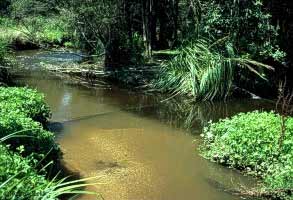|
Water Quality in Waterways and Streams

Water quality is reduced by salt, sediments, nutrients and
suspended organic matter, and in some cases, chemical pollutants.
Organic and clay sediments not only affect the appearance
of water but also carry nutrients, particularly phosphorous,
and microorganisms. Although also absorbed into sediments,
the bulk of the nitrogen in waterways is transported as soluble
nitrates. Phosphorous and nitrogen are responsible for algal
blooms in dams and waterways.
The potential for trees and shrubs to improve water quality
of farm dams and reduce the discharge of nutrients from farms
into waterways and groundwater depends largely on the source
of nutrients and their pathways. The first distinction is
between ‘point’ and ‘diffuse’ sources.
Point sources of nutrients are those areas where high concentrations
of nutrients enter the groundwater or waterways, affecting
water quality. These are usually identified as septic tanks,
dairies, refuse areas etc.
Effluent Plantations
Diffuse sources of nutrients are those areas where low concentrations
of nutrients enter the groundwater or waterways from sources
other than those recognised as point sources. Nutrients are
continually leached from pasture and crop lands, particularly
where soluble fertilisers are used or grazing stocking rates
are high, especially where stock have access to the waterways.
Soil erosion is the main culprit, as it not only removes the
soil, but also the nutrients attached to the soil particles.
Buffer Strips
for Nutrient Trapping
Back to top
|
